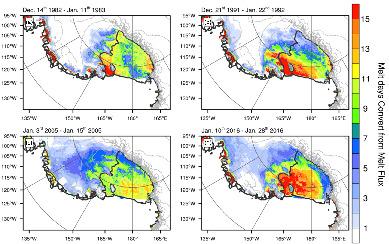当前位置:
X-MOL 学术
›
Q. J. R. Meteorol. Soc.
›
论文详情
Our official English website, www.x-mol.net, welcomes your feedback! (Note: you will need to create a separate account there.)
Major surface melting over the Ross Ice Shelf part II: Surface energy balance
Quarterly Journal of the Royal Meteorological Society ( IF 8.9 ) Pub Date : 2021-05-17 , DOI: 10.1002/qj.4105 Xun Zou 1, 2 , David H. Bromwich 1, 2 , Alvaro Montenegro 2 , Sheng‐Hung Wang 1 , Lesheng Bai 1
Quarterly Journal of the Royal Meteorological Society ( IF 8.9 ) Pub Date : 2021-05-17 , DOI: 10.1002/qj.4105 Xun Zou 1, 2 , David H. Bromwich 1, 2 , Alvaro Montenegro 2 , Sheng‐Hung Wang 1 , Lesheng Bai 1
Affiliation

|
The West Antarctic climate is under the combined impact of synoptic and regional drivers. Regional factors have contributed to more frequent surface melting with a similar pattern recently, which accelerates ice loss and favors global sea-level rise. Part I of this research identified and quantified the two leading drivers of Ross Ice Shelf (RIS) melting, viz. foehn effect and direct marine air advection, based on Polar WRF (PWRF) simulations. In this article (Part II), the impact of clouds and the pattern of surface energy balance (SEB) during melting are analyzed, as well as the relationship among these three factors. In general, net shortwave radiation dominates the surface melting with a daily mean value above 100 W·m−2. Foehn clearance and decreasing surface albedo respectively increase the downward shortwave radiation and increase the absorbed shortwave radiation, significantly contributing to surface melting in areas such as western Marie Byrd Land. Also, extensive downward longwave radiation caused by low-level liquid cloud favors the melting expansion over the middle and coastal RIS. With significant moisture transport occurring over more than 40% of the time during the melting period, the impact from net radiation can be amplified. Moreover, frequent foehn cases can enhance the turbulent mixing on the leeside. With a Froude number (Fr) around 1 or slightly larger, fast downdrafts or reversed wind flows can let the warm foehn air penetrate down to the surface with up to 20 W·m−2 in sensible heat flux transfer to the ground. However, when the Froude number is close to infinity with breaking waves on the leeside, the contribution of turbulence to the surface warming is reduced. With better understanding of the regional factors for the surface melting, prediction of the future stability of West Antarctic ice shelves can be improved.
中文翻译:

罗斯冰架上的主要表面融化第二部分:表面能量平衡
南极西部气候受到天气和区域驱动因素的综合影响。区域因素最近以类似的模式导致更频繁的地表融化,这加速了冰的流失并有利于全球海平面上升。本研究的第一部分确定并量化了罗斯冰架 (RIS) 融化的两个主要驱动因素,即。基于极地 WRF (PWRF) 模拟的焚风效应和直接海洋空气平流。在本文(第二部分)中,分析了熔化过程中云的影响和表面能量平衡(SEB)的模式,以及这三个因素之间的关系。一般来说,净短波辐射在地表熔化中占主导地位,日平均值高于 100 W·m -2. 焚风清除率和降低地表反照率分别增加了向下的短波辐射和增加了吸收的短波辐射,显着促进了玛丽伯德地西部等地区的地表熔化。此外,由低层液体云引起的广泛向下长波辐射有利于 RIS 中部和沿海地区的融化扩张。由于在融化期间超过 40% 的时间发生了显着的水分输送,净辐射的影响可能会被放大。此外,频繁的焚风案例可以增强背风面的湍流混合。弗劳德数 (Fr) 大约为 1 或稍大一些,快速的下沉气流或逆风可以让温暖的焚风空气以高达 20 W·m -2 的功率向下渗透到地表在显热通量传递到地面。然而,当弗劳德数接近无穷大且背风处有碎波时,湍流对地表变暖的贡献就会减少。随着对表面融化区域因素的更好理解,可以改进对南极西部冰架未来稳定性的预测。
更新日期:2021-05-17
中文翻译:

罗斯冰架上的主要表面融化第二部分:表面能量平衡
南极西部气候受到天气和区域驱动因素的综合影响。区域因素最近以类似的模式导致更频繁的地表融化,这加速了冰的流失并有利于全球海平面上升。本研究的第一部分确定并量化了罗斯冰架 (RIS) 融化的两个主要驱动因素,即。基于极地 WRF (PWRF) 模拟的焚风效应和直接海洋空气平流。在本文(第二部分)中,分析了熔化过程中云的影响和表面能量平衡(SEB)的模式,以及这三个因素之间的关系。一般来说,净短波辐射在地表熔化中占主导地位,日平均值高于 100 W·m -2. 焚风清除率和降低地表反照率分别增加了向下的短波辐射和增加了吸收的短波辐射,显着促进了玛丽伯德地西部等地区的地表熔化。此外,由低层液体云引起的广泛向下长波辐射有利于 RIS 中部和沿海地区的融化扩张。由于在融化期间超过 40% 的时间发生了显着的水分输送,净辐射的影响可能会被放大。此外,频繁的焚风案例可以增强背风面的湍流混合。弗劳德数 (Fr) 大约为 1 或稍大一些,快速的下沉气流或逆风可以让温暖的焚风空气以高达 20 W·m -2 的功率向下渗透到地表在显热通量传递到地面。然而,当弗劳德数接近无穷大且背风处有碎波时,湍流对地表变暖的贡献就会减少。随着对表面融化区域因素的更好理解,可以改进对南极西部冰架未来稳定性的预测。


























 京公网安备 11010802027423号
京公网安备 11010802027423号